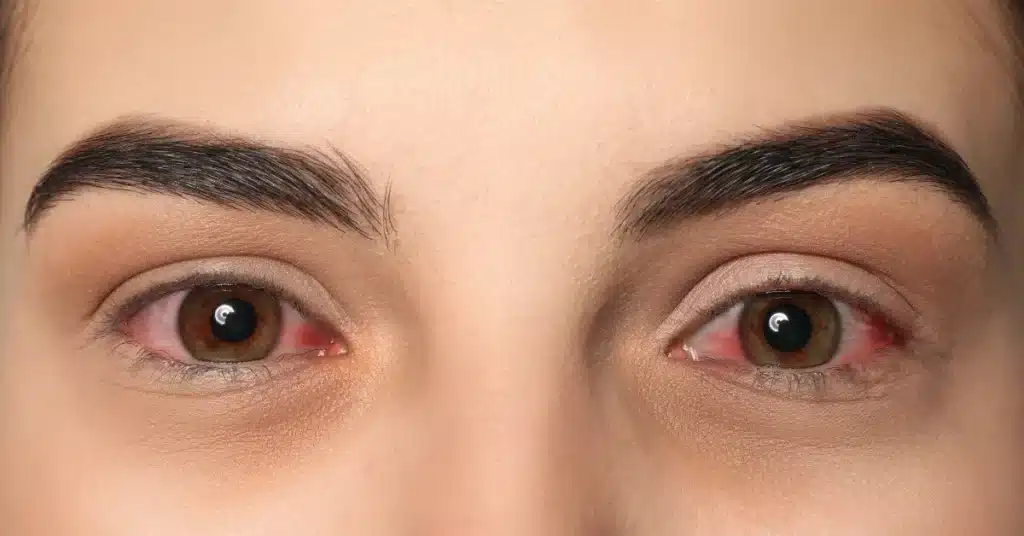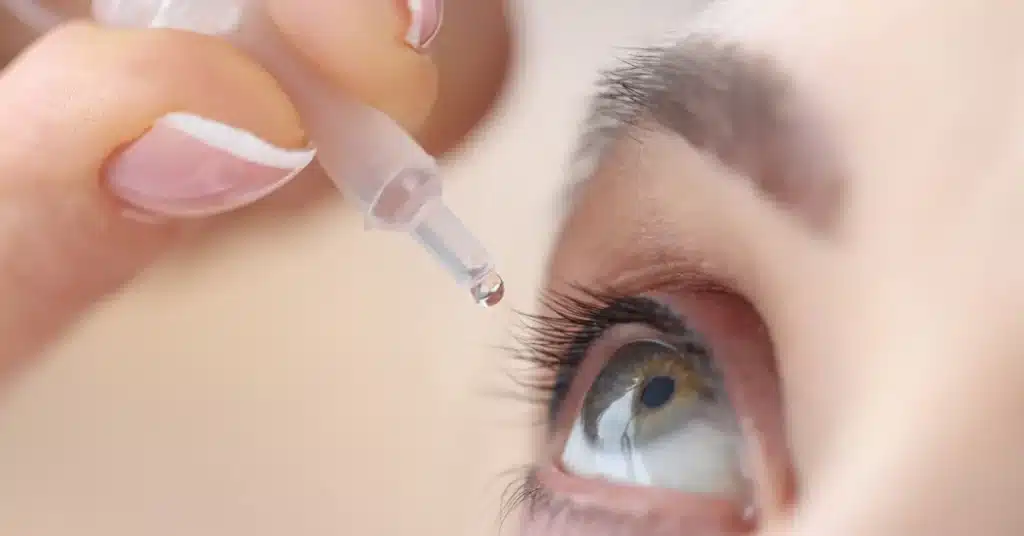Eye discharge is a common symptom resulting from medical conditions like Pink Eye, eye allergies, and more. It is also known as eye gunk or eye boogers.
Eye discharge is a natural part of the body’s defense mechanism, but persistent or abnormal eye discharge requires medical attention.
Let us explore more about eye discharge, its types, causes, symptoms, and treatment options.
What is eye discharge
Eye discharge is a natural fluid produced to cleanse, moisturize, and protect the eyes.
However, one may notice a change in the colour or consistency of the discharge if there is an increase in tear production or eye mucus.
The discharge can be a mixture of mucus, oil, skin cells, and other waste products.
Eye discharge is usually a temporary problem that resolves on its own.
However, consult an eye expert in case of consistent discharge or when other symptoms, like Red Eye, eye pain, or more, accompany it.
Let us further explore the types and causes of eye discharge.
Types of eye discharge
The eye discharge can be different based on color, consistency, and severity.
Identifying the type of eye discharge helps in finding the underlying cause and proper treatment options.
The different types of eye discharge are watery, green, yellow, white, and sticky.
Let us explore all the types of eye discharge in detail.
Green discharge
Green or grayish eye discharge is a serious symptom of bacterial eye infection like Bacterial Pink Eye.
The discharge from Bacterial Pink Eye may result in sticky eyelids when one wakes up.
Other symptoms like Red Eye and irritation can also accompany green eyes.
Consult a doctor to get a full report.
Experiencing green eye discharge and want to know about it in detail. Read: “Green eye discharge”
Yellow Discharge
Yellow mucus discharge from the eyes could mean you have an infection like Stye or Dacryocystitis.
A small lump and a yellow fluid may show up on the eyelid after Stye.
On the other hand, Dacryocystitis may infect the tear drainage system and cause yellow mucus balls in watery tears.
Yellow eye discharge can also be accompanied by symptoms like sensitivity to light, swelling, pain, and more.
Consult an eye expert for a proper eye checkup.
White discharge
White puss discharge can also be a symptom of irritation or an eye infection.
The white discharge might not be harmful because it could be oil and gunk that builds up while you sleep.
However, consistent white eye discharge can be concerning and requires medical attention.
Other types of eye discharge
 Source: africa_images
Source: africa_imagesThe other types of eye discharge include watery discharge and sticky discharge.
Watery discharge is usually transparent and may contain a small amount of mucus.
The eyes produce watery discharge naturally to help clean and lubricate themselves.
However, consistent watery discharge is often linked with a viral eye infection or eye allergies.
On the other hand, sticky eyes are common in the morning and may feel like your eyes have been glued shut.
While it’s a common sign, you should pay attention to the color and texture of the mucus in sticky discharge.
Causes of eye discharge
The causes of eye discharge include Pink Eye, Dry Eyes, contact lenses, Blepharitis, and more.
The factors like color and consistency of the discharge can help identify the underlying cause better.
Let us discuss the causes of eye discharge in detail:
Allergies: Discharge from eye allergies is common, as pollen, dust, or pet dander can cause an allergic reaction and lead to eye discharge.
Contact lens: Irritation and eye discharge can also be caused by unclean contact lenses, infections from improper use, or wearing them too long.
Dry Eye Syndrome: The eyes may produce clear or watery discharge in Dry Eyes. Dry Eyes occur when one’s eyes don’t make enough tears or when they evaporate quickly.
Eye injury: Eye discharge is common due to trauma or injury that can lead to inflammation and increased tear production.
Blepharitis: It is the inflammation of the eyelids that can lead to redness and itching. The condition can lead to a greasy, dandruff-like substance near the base of the eyelashes and cause eye discharge.
Blocked tear ducts: Tears normally drain through small openings called tear ducts. However, individuals may experience excessive tearing and watery eyes if these ducts become blocked.
Environmental irritants: Exposure to smoke, pollutants, or windy conditions can irritate the eyes and lead to increased tear production and eye discharge.
Conjunctivitis: Eye discharge is a common sign of different types of Pink Eye. Pink Eye can cause inflammation of the conjunctiva and lead to eye pain, itching, and discharge.
Want to explore the types of eye discharge caused by Pink Eye? Read: Is Pink Eye Discharge Normal: What You Need to Know
Eye discharge treatment options
The treatment of eye discharge depends on the type and causes of the condition.
Mild cases of eye discharge are temporary and may be treated with the help of home remedies.
However, severe cases of eye discharge may need proper medical attention.
Let us explore all the eye discharge treatment options in detail.
Eye discharge treatment at home
Home remedies are a cost-effective and natural way to deal with eye discharge.
The following remedies may help treat mild cases of eye discharge:
- Warm compress on closed eyelids for a few minutes helps remove crusty discharge and reduce irritation
- Do not touch or rub the affected eyes to prevent irritation and the infection from spreading
- Stop using lenses to reduce the risk of contact lens-related discharge and use prescription glasses
- Maintain proper eyelid hygiene to remove crusty discharge and reduce inflammation
- Do not use eye makeup, as it can increase the risk of contamination and infection
- Patients should avoid allergens and irritants
Clinical treatment for eye discharge
 Source: Syda_Productions
Source: Syda_ProductionsThe doctor may suggest medical treatment options in case of severe eye discharge or when home remedies don’t work.
Also, the treatment of eye discharge depends on the underlying causes.
The doctors may prescribe antibiotic eye drops for treating bacterial infections and reducing yellow or green discharge.
Antihistamine eye drops can be used to provide relief from allergies-induced watery discharge.
On the other hand, artificial tears can help with dry eye discharge and maintain moisture.
Consult an eye expert for proper eye discharge diagnosis and treatment options.
Key takeaways
Eye discharge is a common symptom that can be caused by Pink Eye, contact lenses, eye injury, allergies, and more.
The different types of eye discharge include watery, green, yellow, white, and sticky.
Eye discharge is natural, but persistent eye discharge requires medical attention.
One may try home remedies like warm compresses, using prescription eyeglasses, avoiding makeup, and more to help treat mild eye discharge.
However, in cases of severe eye discharge, the doctor may recommend clinical solutions like eye drops, oral medicines, and more.
Frequently Asked Questions
Is it normal for newborns to have eye discharge?
Yes, it is normal for newborns to have some eye discharge, often caused by a blocked tear duct. The symptom may resolve on its own, but consult a pediatrician in case of consistent discharge.
Can a sinus infection cause eye discharge?
Yes, a sinus infection can cause eye discharge. An inflammation or congestion in the sinuses can increase tear production and lead to watery or thick eye discharge.
Can a person get surgery to treat eye discharge?
Yes, the doctors may recommend surgical treatment like punctal occlusion (closing the tear ducts) or Dacryocystorhinostomy to treat severe eye discharge caused by blocked tear ducts. However, consult a doctor before any surgery or other treatment options.
Is eye discharge contagious?
Yes, eye discharge can be contagious in Bacterial or Viral Pink Eye cases. These infections can spread through direct contact with the discharge. However, allergies or blocked tear duct discharge are not contagious.
When should you see a doctor for eye discharge?
Individuals should consult a doctor if they experience persistent or severe eye discharge. Also, see a doctor if the discharge is accompanied by pain, changes in vision, green or yellow color, or light sensitivity.
What precautions should I take with an eye-discharge patient?
One should maintain good hygiene practices like regular hand washing while dealing with an eye-discharge patient. The patients should avoid touching or rubbing their eyes to prevent irritation and spread of infection.
When referencing outside resources, GoodrxMedicine always provides full citations. To learn more about the measures we use to maintain the quality of our content, please review our Content Information Policy.











